Gardens are often pictured as spacious open spaces where there is ample sunlight. We always succeed in picking the most beautiful plants for these spaces. But there are shady spots in a garden that we often avoid because we don’t know what to do with them. But what if I told you that certain plants thrive in these moist, shady conditions where no other plant can survive?
Ferns are just the plants you need! So, what are Ferns?
Ferns or Polypodiophytes, are a group of plants that do not have a flower or seed and reproduce with the help of spores. They do not have well-defined leaves and instead have complex leaves called megaphylls. The Ferns produce coiled fiddleheads that uncoil and expand into fronds. So, technically leaves that you see on ferns are originally fronds.
Ferns can grow well in moist, shady, and damp places making them the perfect choice for the shady places in your garden. But there are over 10,500 types of ferns discovered so far. How will you select the most suitable one? Here is a list of the top 20 different types of ferns in to choose from.
Different Types of Fern Plants
1. Button Fern
| Scientific Name | Hemionitis rotundifolia |
| Synonyms | Round-leafed fern, Cliff brake |
| Soil type | Moist, well-drained soil |
| Sun exposure | Partial sunlight |
The button fern is a plant endemic to New Zealand and is found in the forests. They are small, evergreen, and compact ferns having more than 30 pairs of round, dark-green, leathery leaf-like structures (pinnae) on fronds. Although the plant is a fern, it does not grow well in the moist, humid conditions that most ferns thrive in.
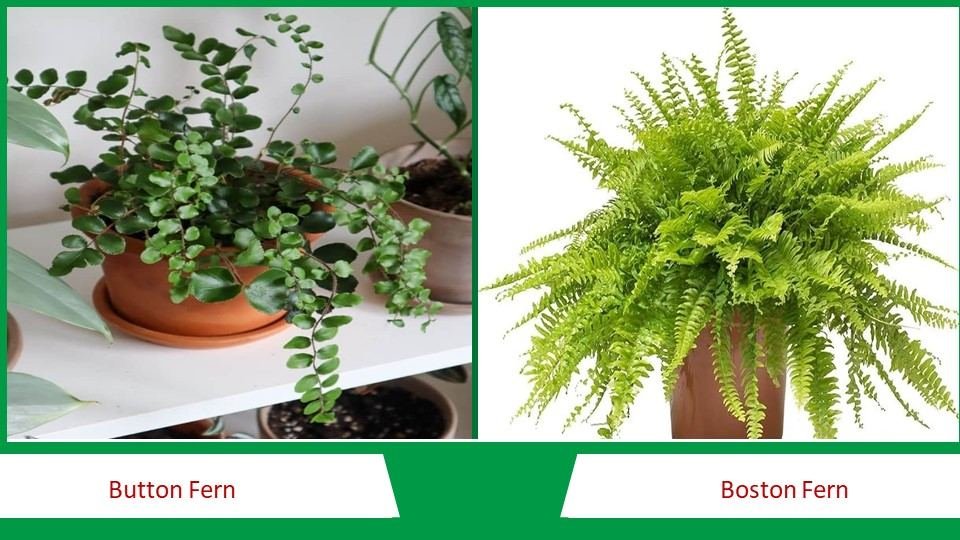
2. Boston Fern
| Scientific Name | Nephrolepis exaltata |
| Synonyms | Sword fern, Boston Bluebell fern, Tuber ladder fern, or Fishbone fern |
| Soil type | Damp but not soggy soil |
| Sun exposure | Full to Partial sunlight |
The Boston fern is an evergreen plant that is native to the Americas and grows to a height of 40-90 cm. The fronds attain a length of 50-250 cm and the leaflets (pinnae) are arranged alternatively on the midrib of the fronds. The fronds are erect in N. exaltata species. The “leaflets” are deltoid with slightly serrated edges. The Boston fern is a hardy plant that can survive even in frost conditions by going dormant during the period.
3. Cretan Brake Fern
| Scientific Name | Pteris cretica |
| Synonyms | Cretan brake, Ribbon fern |
| Soil type | Moist, loose, richly organic soil |
| Sun exposure | Full to Partial sunlight |
The elegant silver and green variegations on the Fronds are the defining features of the Cretan brake or Ribbon fern. They have a silver-to-white stripe running down the center of the light green leaves. The Ribbon fern has arching fronds with more than 5 pinnae on each frond arranged opposite each other. They can thrive well in temperatures above 2℃ but require protection from frost. They are best to be grown indoors in pots in areas where partial sunlight is present.
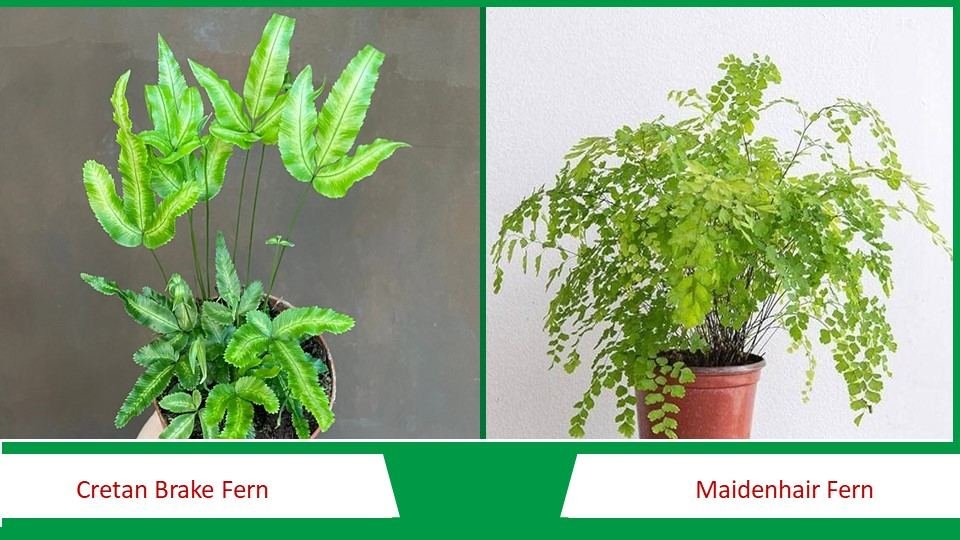
4. Maidenhair Fern
| Scientific Name | Adiantum raddianum |
| Synonyms | Delta maidenhair |
| Soil type | Well-drained soil |
| Sun exposure | Bright indirect sunlight |
Adiantum comes from the Greek word ‘adiantos’ meaning ‘unwetted’ which refers to the shiny leaves which do not absorb water. The Maidenhair fern has shiny, dark leafstalks resembling Human hair, where the name ‘Maidenhair’ fern originated. They grow in the hardest places like rock crevices, coastal cliffs, river banks, coastal cliffs, forest floors, basalt banks, and along trails. The Maidenhair ferns require high humidity, well-drained soil, bright indirect sunlight, and a constant temperature for good growth.
5. Blue Star Fern
| Scientific Name | Phlebodium aureum |
| Synonyms | Golden serpent fern, cabbage palm fern, golden foot fern, hare foot fern |
| Soil type | Moisture-retentive, well-drained soil |
| Sun exposure | Low to moderate sunlight |
The blue star fern has silvery blue-green finger-shaped leaves that make it attractive and a must-have fern in your indoor or outdoor garden. It is an epiphytic, rhizomatous fern and the rhizome is covered in golden-brown scales. They have long, deeply lobed fronds with 20-35 leaflets (pinnae). In areas with year-round rainfall, the blue star fern is an evergreen plant but in areas with dry seasons, they are semi-evergreen. So, irrigation should be properly done to ensure that the plant stays evergreen year-round in your garden.
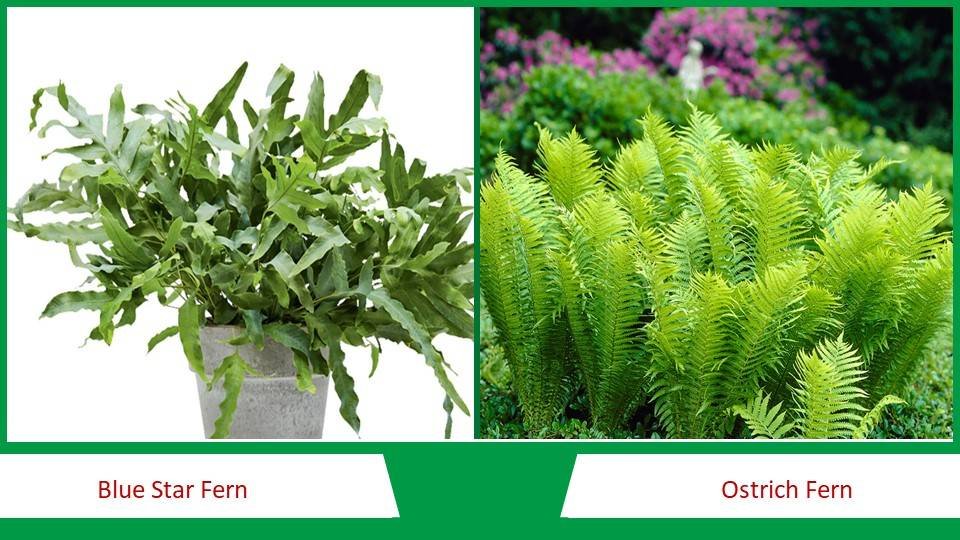
6. Ostrich Fern
| Scientific Name | Matteuccia struthiopteris |
| Synonyms | Fiddlehead fern, Shuttlecock fern |
| Soil type | Moist organically rich soil |
| Sun exposure | Partial to full shade |
Ostrich fern is an elegant plant that is revered for its splendid upright fronds. The fronds are long, branched, and arching and resemble the Ostrich feathers. The fronds originate at the base of the fern clump during the spring and later unfold to become visually striking structures. Ostrich ferns are deciduous plants and they shed their fronds during dry periods. Choosing a place for the ostrich fern is very important as the fern is very expansive and can cover large areas. The Ostrich fern sprouts are a delicacy in Japan and are extensively cultivated.
7. Cinnamon Fern
| Scientific Name | Osmundastrum cinnamomeum |
| Synonyms | Osmunda fern |
| Soil type | Soggy moist soil |
| Sun exposure | Deep to filtered sunlight |
Number 7 on the types of fern plants is the Cinnamon fern. The fronds define the beauty of a fern. Cinnamon ferns are lucky in this aspect. The cinnamon fern has two types of fronds, a fertile frond and a sterile frond. The fertile fronds are short, erect, and spore-bearing and becoming cinnamon-colored. The sterile fronds are tall and spreading with broad, deeply lobed pinnae. Deep shade would also enhance their growth.
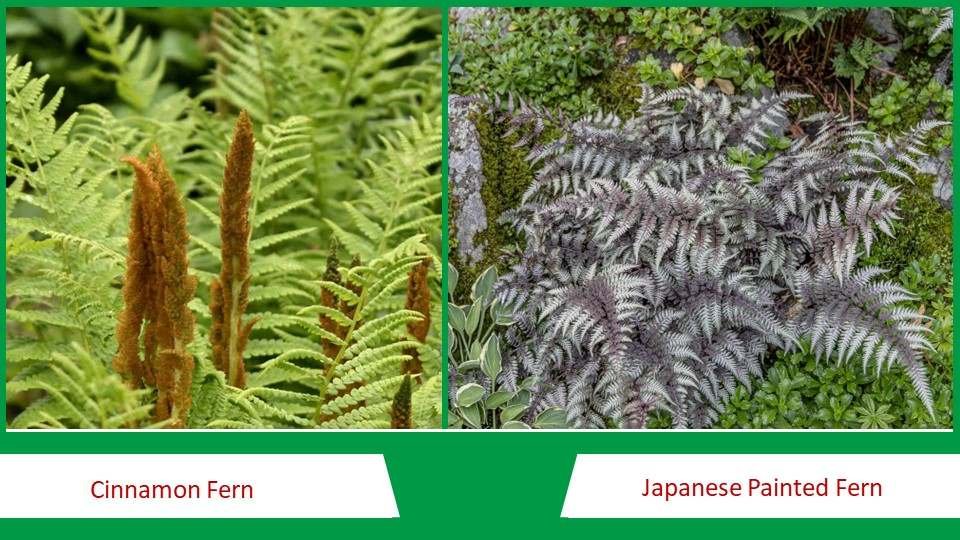
8. Japanese Painted Fern
| Scientific Name | Athyrium niponicum |
| Synonyms | Silver fall, Japanese fern |
| Soil type | Moist, well-drained soil |
| Sun exposure | Deep to partial shade |
The Japanese Painted fern owns an unmatched elegance that stands out from the rest of the fern world. Unlike the greenish ferns, the Japanese ferns are more vibrant with silver-colored triangular fronds mixed with greyish-green and a purplish midrib. The fronds are variegated and arching. Other than that they are very hardy and can survive in extreme conditions like acidic soils and deep shade.
9. Bird’s Nest Fern
| Scientific Name | Asplenium nidus |
| Synonyms | Spleenworts |
| Soil type | Moisture-retentive, loamy, well-drained soil |
| Sun exposure | Low to moderate sunlight |
The Bird’s Nest fern is found in China, Japan, Korea, and Taiwan. They have bright green fronds that are arching and have pointed ends and a strong midrib. The fern can grow up to 60-90 cm in length. The fronds are extremely smooth. Spleenworts are an excellent choice for bathroom decorations as they can thrive in warm, and humid environments. It is preferable to plant the fern in a peat-based potting mixture for prolific growth.
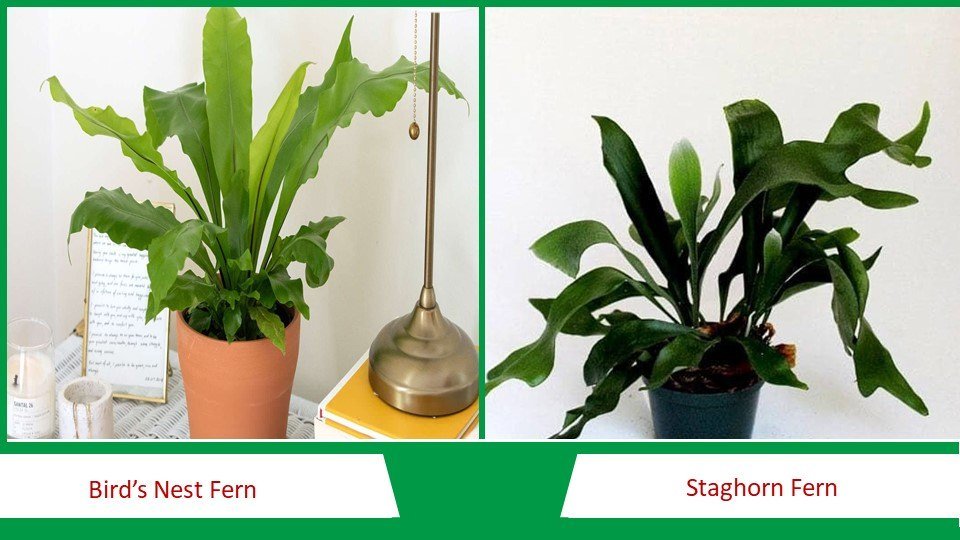
10. Staghorn Fern
| Scientific Name | Platycerium bifurcatum |
| Synonyms | Staghorn fern, Elkhorn fern |
| Soil type | Moist but well-drained sandy soil |
| Sun exposure | Partial sunlight to partial shade |
The staghorn fern is noted for its striking appearance and is an easy choice for your garden. However, the fertile fronds are round and flat, and anchor the plant to its position. Staghorn ferns are grown in hanging pots or mounted on walls. The staghorn ferns can grow tall to 60-90 cm in length.
Also Read
11. Man Fern
| Scientific Name | Dicksonia antartica |
| Synonyms | Soft tree fern, Man fern |
| Soil type | Moist organic soil |
| Sun exposure | Partial shade |
Man fern is an evergreen tree fern that originated in Australia. They have an erect rhizome forming a trunk and grow to 15 m in length. The large spreading canopy of 2-6 m diameter is their most elegant feature. The canopy is formed of large, dark green, strikingly textured fronds. The fertile and sterile fronds are arranged in alternative layers. Man ferns are extremely adaptive and grow well in acid, alkaline, and neutral soils.
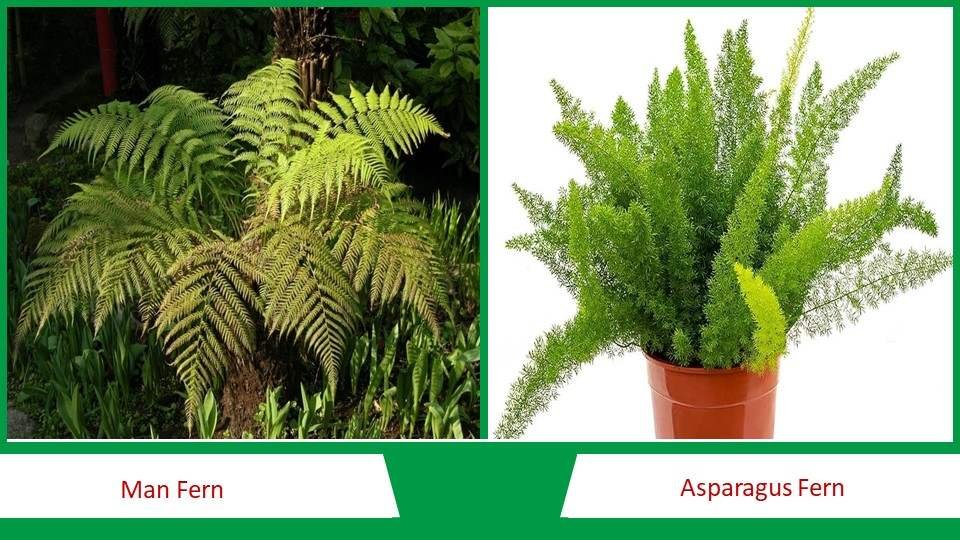
12. Asparagus Fern
| Scientific Name | Asparagus aethiopicus, A. densiflorus |
| Synonyms | Common asparagus fern, Asparagus grass, lace fern, climbing asparagus, ferny asparagus |
| Soil type | Well-drained organic-rich potting mixture |
| Sun exposure | Partial sunlight outdoors and bright indirect light outdoors |
Asparagus fern comes in at number 12 in the list of ferns. The asparagus fern is not a true fern but is acknowledged as one because of its fern-like leaves. If unattended, these ferns spread rapidly in the garden like an invasive weed and will be difficult to control. There are sharp thorns on the stem so it’s advised to exercise caution while handling them.
13. Macho Fern
| Scientific Name | Nephrolepsis biserrata |
| Synonyms | Giant sword fern |
| Soil type | Moist but well-drained soil |
| Sun exposure | Partial sunlight to full shade |
Macho ferns are the largest of all sword ferns. Due to their large size, the macho ferns are used for outdoor gardens however, they are apt for large spacious rooms indoors. The macho ferns thrive in shady, humid environments like swamps.
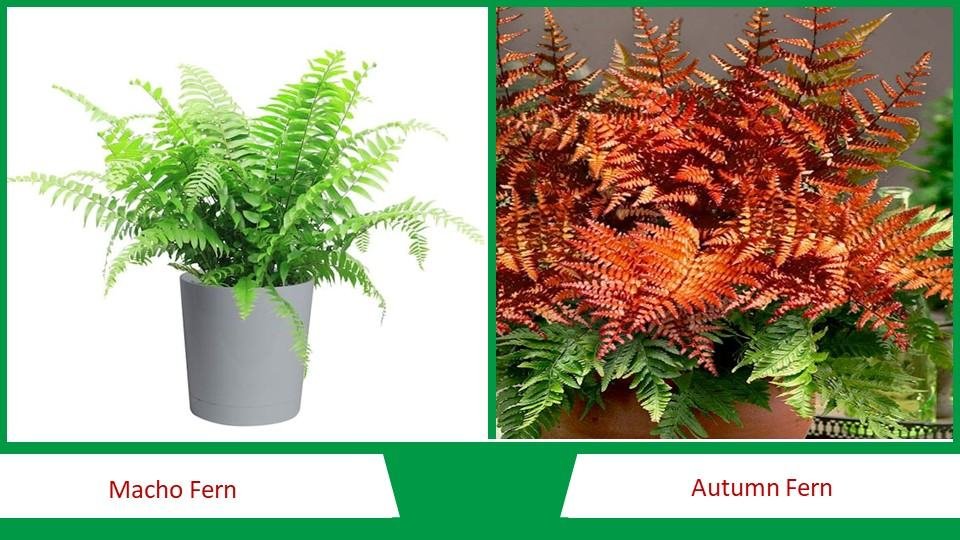
14. Autumn Fern
| Scientific Name | Dryopteris erythrosora |
| Synonyms | Autumn fern, Japanese shield fern |
| Soil type | Moist, well-drained, humus-rich soil |
| Sun exposure | Shade-loving |
The autumn fern or the Japanese shield fern is a semi-evergreen fern that grows in light woodland shade on low mountains or hills in East Asia. they have 30-70 cm long bipinnate fronds with broad pairs of pinnae. Their most attractive feature is the coppery tint on the young fronds that transition to dark green on maturation. They thrive on moist, humus-rich, neutral soil with a pH range of 6.1 to 7.5. They are suitable for small spaces due to their slow growth rate and small spread area.
15. Lemon Butter Fern
| Scientific Name | Nephrolepis cardifolia ‘Duffi’ |
| Synonyms | Button sword fern, erect sword fern, little leaved sword fern, and fishbone fern |
| Soil type | Moist, loamy but well-drained soil |
| Sun exposure | Partial to full shade |
The Lemon Butter fern is called so because of the lemony scent it produces when crushed. They are a dwarf version of the common Button fern. The pleasant lemony aroma given off by the leaves is another good reason why they are the perfect indoor plants. When growing indoors, indirect bright light is suitable along with consistent irrigation.
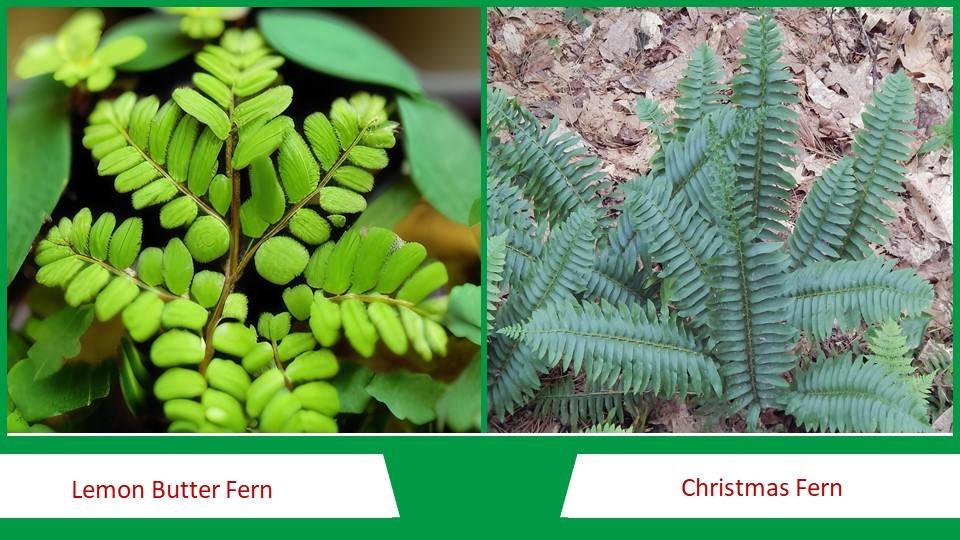
16. Christmas Fern
| Scientific Name | Polystichum acrostichoides |
| Synonyms | Christmas fern |
| Soil type | Moist well-drained soil |
| Sun exposure | Partial to full shade |
Christmas ferns are found growing in woodlands, streambanks, and rocky slopes and are one of the most common ferns in eastern North America. The fronds are evergreen even during the winter seasons, hence the name. The fronds arise from a central growth point. The developing fronds are coiled, scaly, greyish, and prominent and are called crosiers. The Christmas ferns are planted in clusters on slopes to control soil erosion.
17. Lady Fern
| Scientific Name | Athyrium filix-femina |
| Synonyms | Common lady fern, Female fern |
| Soil type | Moist, sandy, nutrient-rich, well-drained soil |
| Sun exposure | Shade to partial sun |
Lady ferns are large, deciduous ferns that are native to temperate Asia, Europe, North Africa, Canada, and the US. Their fronds are feathery and their reproductive structures are concealed in an inconspicuous – deemed “female” way hence the name Lady fern or Female fern. The deciduous fronds are broad and light yellow-green colored. The reproductive structures or sori are found on the underside of the fronds. The fronds are green during the summer and turn golden-yellow after the winter.
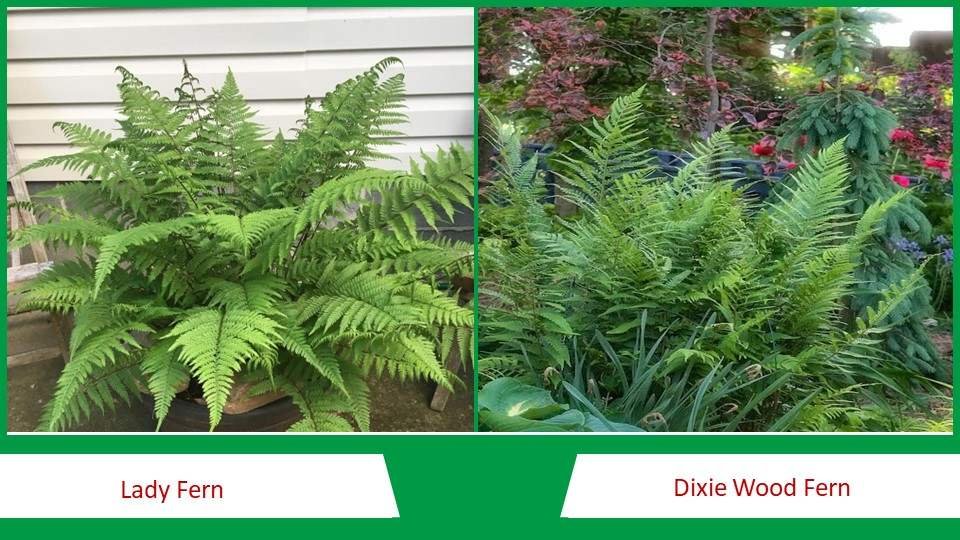
18. Dixie Wood Fern
| Scientific Name | Davallia spp. |
| Synonyms | Rabbit’s foot fern, Rabbit’s foot, Hare’s foot, Squirrel’s foot, Deer’s foot fern |
| Soil type | Moist, loamy but well-drained soil |
| Sun exposure | Partial sunlight |
Rabbit’s foot fern is a perennial fern that arises from creeping scaly rhizomes that consist of fine, fur-like mats of hairs on their surface. These furry, brown, and yellow rhizomes look like a rabbit’s foot. They thrive in cool temperatures in the range of 15 – 24℃ and cannot survive below 13℃. Humid conditions are good for the growth of the fern and is recommended to mist the ferns in the absence of humid conditions.
19. Australian Sword Fern
| Scientific Name | Nephrolepis obliterata |
| Synonyms | Australian sword fern, Kimberley queen fern |
| Soil type | Moist, well-drained soil |
| Sun exposure | Little or no sunlight |
The fern thrives in the temperature range of 16℃ to 24℃ and prefers bright indirect sunlight. They are sensitive to watering, so ensure that the soil is well drained between waterings.

20. Western Sword Fern
| Scientific Name | Polystichum munitum |
| Synonyms | Western sword fern |
| Soil type | Well-drained, humus-rich, acidic soil |
| Sun exposure | Partial to complete shade |
The Western Sword fern can be found growing in the understory of moist coniferous woodlands at low altitudes. The fronds have numerous leaflets alternating on the stalk with serrated edges. the fronds spread horizontally when grown in shade and spread vertically with increased exposure to sunlight. The young plants have pale green leaves with short pinnae. It prefers cool weather but is hardy enough to survive droughts.
Also Read
Conclusion
Today we have gone through a list of 20 best types of fern plants that can make your gardens more attractive. Apart from their elegance what makes ferns the best choice in a garden is their easy maintenance. Ferns require very little caring and can grow in shady corners of the garden. You don’t need to think more, just select a beautiful fern from this list and go plant it in your garden.
Latest Post
- Top 10 Agricultural Drone Companies in India
- December Issue 2025- Times of Agriculture Magazine
- November Issue 2025- Times of Agriculture Magazine
- Punjab & Sind Bank Introduces Special Program to Support Food and Agro-Processing Sector
- Beyond Classrooms and Gardens: How a Professor Turned His Passion into Purpose
- October Issue 2025- Times of Agriculture Magazine
- Top 10 Pesticide Companies in the World
- September Issue 2025- Times of Agriculture Magazine
- Top 15 Fertilizer Companies in the World











